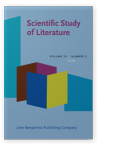Vol. 10:2 (2020) ► pp.167–192
Fact or fiction?
Clarifying the relationship between reading and the improvement of social skills
Many studies have claimed to find that reading fiction leads to improvements in social cognition. But this work has left open the critical question of whether any type of narrative, fictional or nonfictional, might have similar effects. To address this question, as well as to test whether framing a narrative as fiction matters, the current studies presented participants (N = 268 in Study 1; N = 362 in Study 2) with literary fiction texts, narrative nonfiction texts, expository nonfiction texts, or no texts. We tested their theory-of-mind abilities using the picture-based Reading the Mind in the Eyes task and a text-based test of higher-order social cognition. Reading anything was associated with higher scores compared to reading nothing, but the effects of framing and text type were inconsistent. These results suggest that prior claims regarding positive effects of reading fiction on mentalizing should be seen as tenuous; other mechanisms may be driving previously published effects.
Article outline
- The current studies
- Study 1
- Methods
- Participants
- Materials
- Fiction texts
- Nonfiction texts
- Non-narrative texts
- Theory of mind measures
- Other measures
- Procedure
- Results
- Coding and preliminary analyses
- Reading something vs. nothing
- Reading narrative vs. non-narrative texts
- Effects of both story type and presentation type
- Discussion
- Methods
- Study 2
- Methods
- Participants
- Materials
- Texts
- Measures
- Procedure
- Results
- Reading something vs. nothing
- Effects of both story type and presentation type
- Discussion
- General discussion
- Methods
- Acknowledgements
-
References
